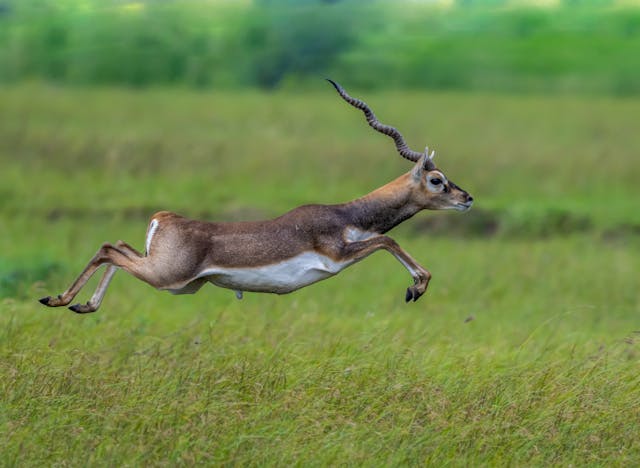
Why can animals jump higher and farther than us? They have more muscles, more elastic joints, tails, more speed, and they can impart more power into the ground. Note, I am going to look at mammals, not insects, which can jump many times their own body length.
The highest a human can jump is 2.45 m, which is the high jump world record for men. The farthest a human has ever jumped is 8.95 m, which is the long jump world record for men. Both of these distances have stood for a very long time (over 30 years in both cases) because the people who jumped them are outliers. Some people have theorized that Usain Bolt could possibly jump a 9 m, and maybe even 10 m if the conditions were perfect. This is down to his speed. A huge part of the long jump is the speed the jumper reaches before they jump. You can see this with anything. If you drive two cars over a jump and one is going faster than the other, the faster car will go farther. A high jumper needs to have speed, but also very elastic muscles and the ability to bounce. If you watch videos of the high jump and the long jump records, you can see that the athletes obviously have speed into the takeoff, but they use their arms as pendulums and their bodies as springs to try to eke out more distance.
These athletes are probably very close to the maximum distance and height that a human can jump. They are the pinnacle of human ability and yet they are dwarfed by many animals. Animals would destroy the high jump record easily. A regular housecat can jump about 180 cm, and some have been known to jump 240 cm, from standing! A tiger can jump about 4.5 m, from a standing jump. The highest known jump by a mammal was a 7 m standing jump by a puma. Another puma even jumped 3.6 m into a tree from standing while carrying the carcass of a deer in its mouth. Many animals would also smash the long jump record. Lions and tigers can leap 10 m. A kangaroo can jump about 13 m while it is hopping. A cougar can leap 14 m.
So, why can animals jump so much higher and farther than even our best athletes? Let’s look at vertical jump first. The first reason is their muscles. Tigers have very large hind legs that have enormous muscles. Being able to jump high is a matter of simple physics. An animal needs to be able to convert the potential energy in their muscles into kinetic energy. The way to do that is to have lots of fast twitch muscles that can release the force very quickly against the ground. The force the muscles can apply to the ground is incredible and tigers have to have extra dense bones in their legs to deal with the force. The second reason is their spines. They are far more flexible than we are, and they can compress their spines. This allows them to store elastic energy there as well, which is released when they jump, just like a spring, helping them get even higher. The third reason is their joints. Our joints are mostly set in sockets of bone, but tigers and cats have joints that are connected by muscle and not bone, which allows them to be more flexible and twist more. They can store more elastic energy here and they can pendulum themselves to get more height. The fourth reason is their tails. In the same way that a long jumper spins their arms, a tiger can spin its tail to get more height and to balance in flight. And, lastly, they have claws which grip the ground and avoid slippage. High jumpers wear spikes because they don’t want to waste any energy to forwards or backwards movement. Tigers are the same and their claws allow them to impart all of their force into the ground.
Their long jump ability is given by many of the reasons that allow them to jump so high, but their speed comes into play here. The reason that Usain Bolt is predicted to do a longer long jump is because he has more speed than the current world record holder. Tigers have more speed again. They can run at about 65 km/h, which is twice as fast as Usain Bolt. That coupled with their claws that grip the ground allow them to put more force into the ground and jump farther. Their strong muscles launch them into the air and their flexible spines and joints help them to fly like a spring, all giving them much greater distance. And this is what I learned today.
Photo by Munna Mandalapu : https://www.pexels.com/photo/photo-of-a-jumping-antelope-13845978/
Sources
https://en.wikipedia.org/wiki/Long_jump
https://protectapet.com/en-jp/blogs/blog/how-high-does-a-cat-fence-need-to-be
https://www.guinnessworldrecords.com/world-records/86935-highest-jump-by-a-mammal
https://sciencing.com/how-fast-does-tiger-run-4690011.html
https://www.ccmr.cornell.edu/faqs/why-are-cats-so-flexible
https://www.beemat.co.uk/blogs/beemat/how-high-can-mammals-jump
https://kidszoo.org/wp-content/uploads/2020/07/Tigers-Leaping-Ability.pdf
https://sports.yahoo.com/high-cats-jump-honestly-pretty-025515533.html
